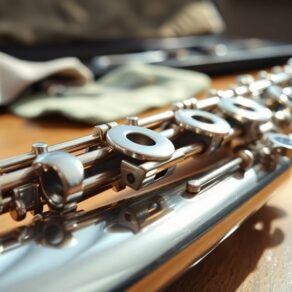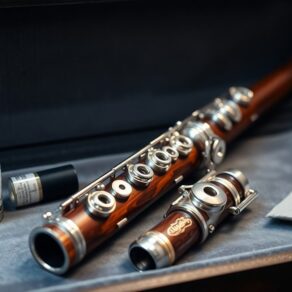If you're exploring flute solos that truly showcase talent, consider pieces like "Carmen Fantasy" by Franz Waxman, which captures intense emotions and technical skills. Mozart's "Concerto in G" displays the instrument's range and intricate artistry. "Dances of the Blessed Spirits" by Gluck offers lyrical beauty, while "Suite for Flute" by Takemitsu merges cultural influences seamlessly. Fauré's "Fantasie" and Ibert's "Concerto for Flute" challenge flutists with their expressive demands. Each solo presents unique techniques and vibrant storytelling. By examining these works, you'll discover the depth and versatility of flute music waiting to inspire you.
Key Takeaways
- "Fantasie" by Gabriel Fauré highlights the flute's emotional depth, showcasing nuanced expressions that engage listeners on a personal level.
- "Concerto for Flute" by Jacques Ibert combines technical brilliance with jazz influences, demonstrating the flute's expressive capabilities and virtuosic demands.
- "Cinq Incantations" by André Jolivet features advanced techniques and mysticism, pushing the boundaries of flute performance and interpretation.
- "Sonatine" by Pierre Boulez exemplifies innovative rhythmic patterns, creating a rich dialogue between flute and piano that showcases technical mastery.
- "Carmen Fantasy" by Franz Waxman channels intense emotion and character, allowing flutists to display both technical skill and expressive storytelling.
"Carmen Fantasy" by Franz Waxman

Franz Waxman's "Carmen Fantasy" stands out as a remarkable showcase for flutists, blending the rich melodies of Bizet's opera with intricate technical demands. From the very first notes, you're immersed in a world where Carmen themes intertwine seamlessly with Waxman style. The piece is a thrilling ride, inviting you to explore the depths of emotion and virtuosity inherent in the flute.
As you navigate through the various sections, you'll notice how Waxman masterfully reinterprets iconic melodies from "Carmen," allowing you to express passion and drama. Each phrase requires not just technical skill but also an understanding of the character behind the music. The soaring lines demand a rich tone and precise articulation, pushing your capabilities to new heights.
The rhythmic complexities will challenge your dexterity, but they also create a sense of excitement that captivates both performer and audience.
In addition to technical prowess, "Carmen Fantasy" provides an opportunity for deep emotional connection. You find yourself channeling the fiery spirit of Carmen, transforming the stage into a vibrant landscape of love, jealousy, and defiance.
This piece isn't just about playing notes; it's about telling a story. As you breathe life into each phrase, you'll feel a sense of belonging to a larger tradition, one that celebrates the beauty and brilliance of the flute within the context of classic opera. Choosing a reliable beginner flute brand can greatly enhance your performance experience as you tackle such challenging pieces.
Embrace the journey, and let Waxman's remarkable work inspire your artistry.
"Sonata for Flute" by Francis Poulenc
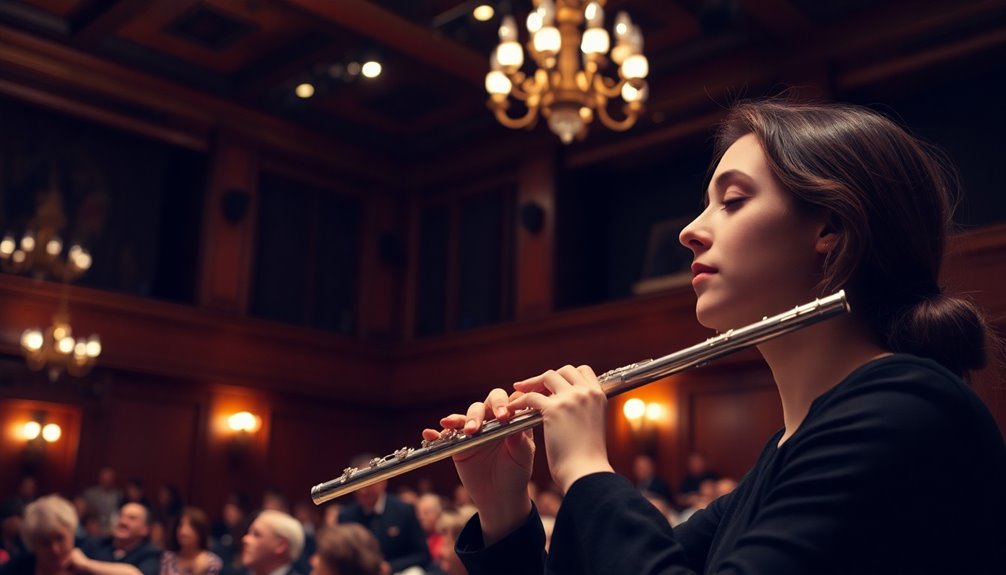
Exploring Francis Poulenc's "Sonata for Flute" reveals an enchanting blend of elegance and complexity that challenges flutists to showcase their artistry. This piece isn't just a test of technical skill; it's a journey through Poulenc's influences, including the vibrancy of French musical heritage and the expressive depth of early 20th-century styles.
As you immerse yourself in the sonata, you'll find moments that demand both precision and emotional nuance, pushing your flute technique to its limits.
Here are some key elements that make Poulenc's sonata a standout:
- Expressive Melodies: Each phrase feels like a conversation, drawing listeners in.
- Rhythmic Diversity: The interplay of different rhythms keeps the audience engaged.
- Harmonic Richness: You'll discover unexpected shifts that add depth to the music.
- Dynamic Contrast: The use of soft and loud passages creates an emotional landscape.
- Technical Demands: Challenging passages will test your agility and control.
When you play Poulenc's "Sonata for Flute," you're not merely performing notes; you're telling a story filled with joy, melancholy, and reflection.
This piece invites you into a world where your artistry can shine. It's a perfect opportunity to connect with fellow musicians who appreciate the beauty and complexity of flute repertoire, fostering a sense of belonging within the vibrant community of flutists. Additionally, engaging with this sonata enhances your technical skills development, which is essential for any flutist's growth.
Embrace the challenges, and let your interpretation resonate with your audience.
"Concerto in G" by Wolfgang Amadeus Mozart
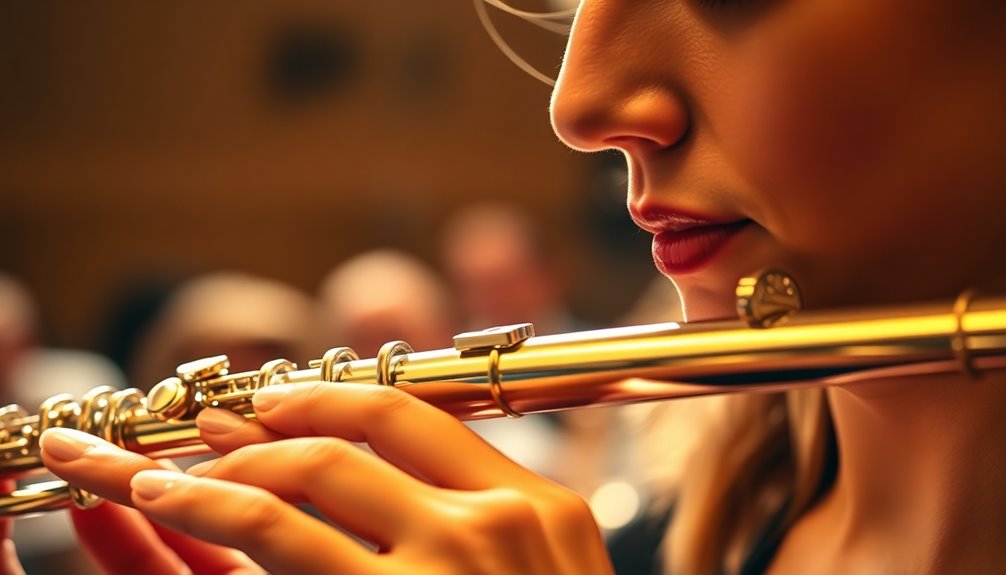
Wolfgang Amadeus Mozart's "Concerto in G" is a brilliant showcase of the flute's capabilities, allowing performers to shine with both technical prowess and expressive depth. This piece, composed in G Major, reflects Mozart's influence on the classical repertoire, blending elegance with virtuosity. As you explore this concerto, you'll notice how the interplay between the solo flute and the orchestra creates a dialogue that captivates both musicians and audiences alike.
The first movement bursts forth with an infectious energy, inviting you to engage with the intricate melodies and swift passages. You'll find yourself maneuvering rapid runs that demand precision, while the lyrical sections provide a chance for emotional expression.
In the slow second movement, the flute's voice takes on a more introspective character, allowing you to convey deep sentiments through delicate phrasing and dynamic control. This contrast showcases the instrument's versatility, making it a favorite among flutists.
The final movement returns to a lively tempo, where you can release your technical skills. The playful spirit of this movement highlights the joy inherent in Mozart's music, encouraging you to connect with the audience through infectious enthusiasm.
As you perform the "Concerto in G," you not only join a long tradition of flutists but also become part of the legacy that Mozart has left behind. Embrace this opportunity to express both your technical abilities and your unique musical voice, celebrating the timeless beauty of this extraordinary work. This concerto serves as an excellent example of diverse repertoire that fosters skill enhancement and artistic expression.
"Dances of the Blessed Spirits" by Christoph Willibald Gluck

Following the elegant intricacies of Mozart's "Concerto in G," Christoph Willibald Gluck's "Dances of the Blessed Spirits" offers a different yet equally enchanting perspective on flute performance. This piece invites you to explore the harmonious blend of melody and emotion, showcasing Gluck's influence on the world of dance interpretation in music.
As you investigate the work, you'll notice how the flute weaves through delicate phrases, mimicking the ethereal movement of spirits. The piece embodies a sense of grace and fluidity, transporting you to a domain where each note feels like a gentle caress.
Here are a few elements that stand out:
- Lyrical Phrasing: Each line dances gracefully, creating a hauntingly beautiful atmosphere.
- Expressive Dynamics: The contrasts in volume emphasize the emotional depth of the piece.
- Rhythmic Flow: The syncopated rhythms keep you engaged, echoing the essence of dance.
- Melodic Contours: Gluck crafts a melody that rises and falls, evoking a sense of longing.
- Imagery of Nature: The music conjures images of serene landscapes, enhancing the listening experience.
In "Dances of the Blessed Spirits," Gluck's influence is palpable, reminding you of the emotional storytelling possible through the flute. This piece not only showcases technical skill but also invites you to connect with the spirit of dance, fostering a sense of belonging within the world of classical music. Additionally, the use of the alto flute's rich tone allows for an even deeper emotional resonance that enhances the overall performance.
"Suite for Flute" by Tōru Takemitsu
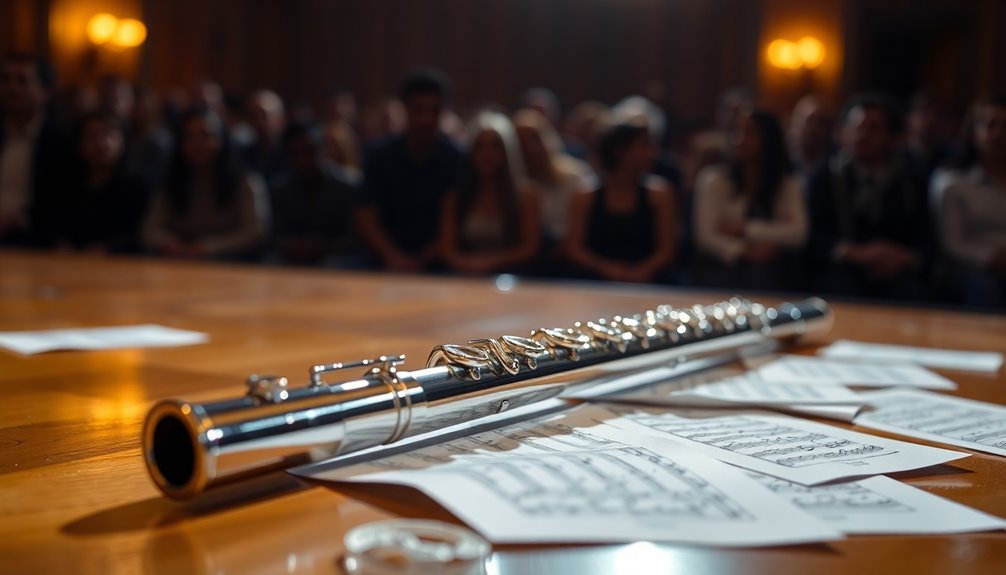
Tōru Takemitsu's "Suite for Flute" stands out as a remarkable fusion of traditional Japanese aesthetics and Western classical techniques, making it an enthralling addition to the flute repertoire. In this enthralling work, you'll find a blend of delicate melodies and intricate rhythms that reflect Takemitsu's influences, drawing from both Eastern and Western musical traditions.
As you explore the piece, you'll notice how Takemitsu employs innovative flute techniques that transform the instrument into a vehicle for expressive storytelling. The use of breathy tones and flutter-tonguing creates an ethereal quality, inviting listeners to immerse themselves in a soundscape that feels both familiar and foreign.
Each movement presents unique challenges, pushing flutists to master a range of dynamics and articulations, which ultimately enhances their technical prowess. Practicing regularly with methods like the Rubank Elementary Method can help develop these essential skills.
The interplay between silence and sound is another hallmark of "Suite for Flute." Takemitsu skillfully manipulates pauses, allowing moments of introspection that resonate deeply with audiences. This contrasts beautifully with the more vigorous passages, showcasing the flutist's ability to convey emotion through varied techniques.
In your performance, you'll not only showcase your technical skills but also invite listeners to share in a cultural journey that transcends boundaries. Takemitsu's work serves as a bridge, connecting diverse musical worlds and fostering a sense of belonging in the universal language of music.
Embrace the challenge of this suite, and let it reveal the beauty of your artistry.
"Sonatine" by Pierre Boulez
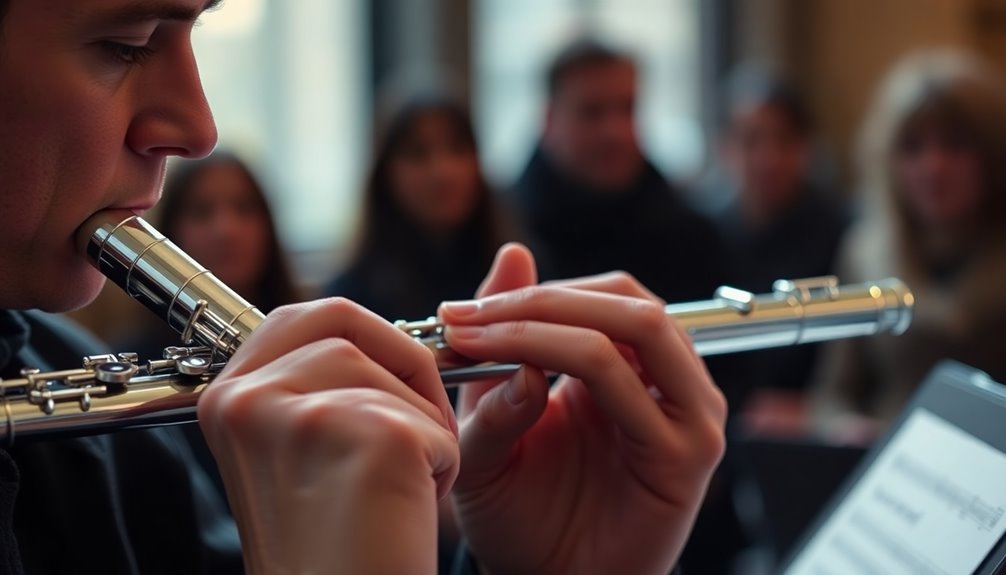
Immerse yourself in Pierre Boulez's "Sonatine," a groundbreaking work that pushes the boundaries of flute composition. This piece exemplifies Boulez's innovative techniques and his ability to weave contemporary influences into a cohesive and engaging musical narrative. As you explore the various sections, you'll notice how each element contributes to the overall experience, inviting you to engage on a deeper level.
- Intricate rhythmic patterns challenge your perception of time.
- Extended techniques showcase the flute's versatility and range.
- A dialogue between the flute and piano creates a rich tapestry of sound.
- Boulez's use of silence adds tension and anticipation.
- The dynamic shifts reflect emotional complexity and depth.
Boulez's techniques in "Sonatine" often defy traditional expectations, creating a language uniquely his own. You'll hear the flute soaring through dissonance, employing multiphonics and flutter-tonguing, which reflect the spirit of modernism. Each note feels intentional, echoing the composer's vision of a world where music evolves continuously.
Articulation techniques, such as tongue placement, play a crucial role in enhancing the clarity and expressiveness of the flute passages you encounter in this work.
As you explore this masterwork, you'll likely find yourself enthralled by its intricacies. Boulez's contemporary influences resonate throughout, making "Sonatine" not just a performance piece but a profound exploration of sound and emotion.
It challenges you to listen actively, to embrace the unexpected, and to appreciate the artistry behind every phrase. In this way, Boulez invites you into a community of listeners who value innovation, creativity, and the transformative power of music.
"Concerto for Flute" by Jacques Ibert
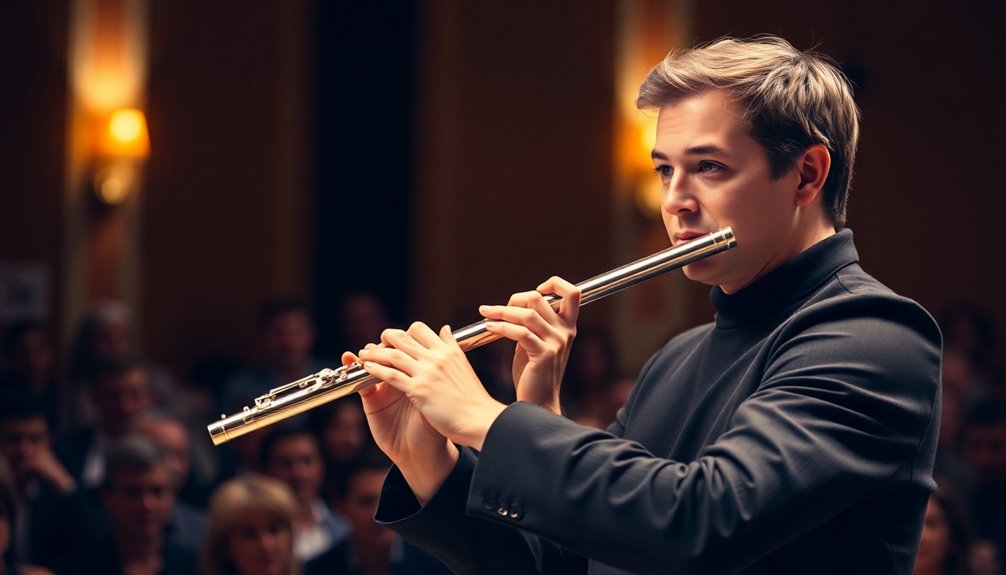
Jacques Ibert's "Concerto for Flute" stands out as a vivid showcase of the instrument's expressive capabilities and technical brilliance. Written in the 1930s, this piece reflects Ibert's influences from various modern compositions, blending elements of jazz and classical styles. The concerto structure is intricate, featuring three contrasting movements that invite you to explore a rich tapestry of emotions.
As you immerse yourself in the performance, you'll notice the distinctive flute techniques required to navigate its demanding passages. The soloist faces significant performance challenges, from rapid runs that test technical mastery to lyrical sections that call for deep emotional expression. Each note must resonate with the listener, creating an intimate connection through the art of interpretation.
Ibert's orchestral collaboration is equally compelling; the flute dances above a vibrant orchestral backdrop, enhancing the overall sonic experience. This interplay showcases not only the flute's agility but also its ability to convey profound feelings, cleverly reflecting the historical context of the time.
For the soloist, the "Concerto for Flute" is a thrilling journey, demanding both precision and passion. The way you interpret the nuances of Ibert's writing can transform the performance, inviting your audience to share in the emotional landscape of the piece. Mastery of advanced flute techniques is essential to fully realize the potential of this challenging work.
Ultimately, this concerto isn't just about technical ability; it's a celebration of the flute's voice in modern music, inviting you to become part of its rich legacy.
"Cinq Incantations" by André Jolivet
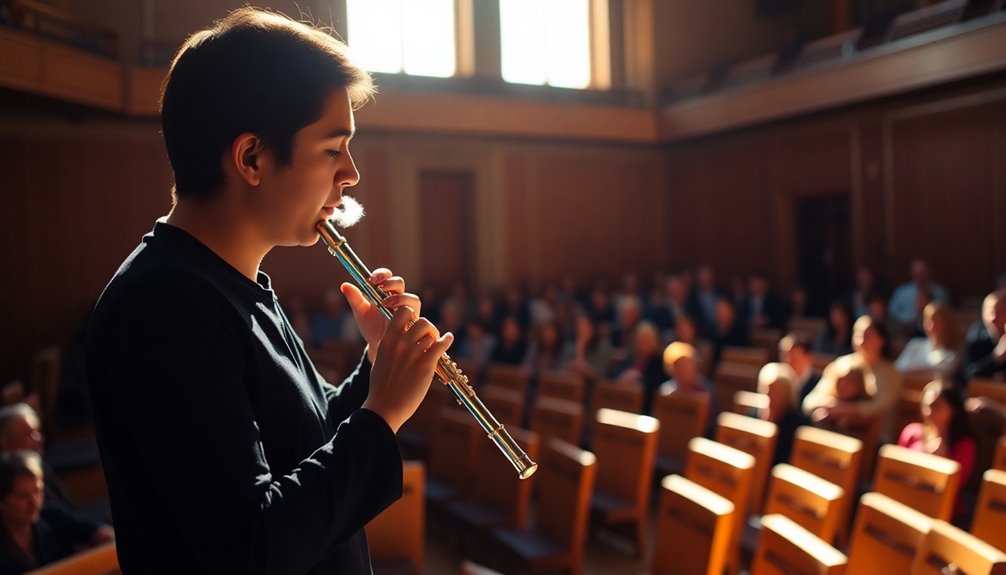
André Jolivet's "Cinq Incantations" offers an intriguing exploration of the flute's capabilities, blending mysticism with technical prowess. This piece draws you into a world where the flute not only sings but also whispers secrets of ancient rituals.
Jolivet's inspiration stems from his fascination with various cultures and their spiritual practices, infusing each incantation with a sense of purpose and depth.
As you investigate this work, you'll notice several key elements that define its allure:
- Contrast of Dynamics: The piece masterfully fluctuates between soft, haunting tones and powerful, commanding blasts.
- Rhythmic Complexity: Jolivet uses intricate rhythms that mirror the heartbeat of a ritualistic ceremony, keeping you engaged throughout.
- Extended Techniques: You'll encounter multiphonics and flutter-tonguing, showcasing the flute's versatility and expanding its sonic palette.
- Imagery of Nature: The music evokes natural elements, pulling you into a landscape where the earth and sky intertwine.
- Mystical Undertones: Each incantation feels like a spell, creating an atmosphere that's both enchanting and otherworldly. Additionally, mastering breath control is crucial for effectively conveying the emotional depth of the piece through dynamic phrasing.
"Fantasie" by Gabriel Fauré
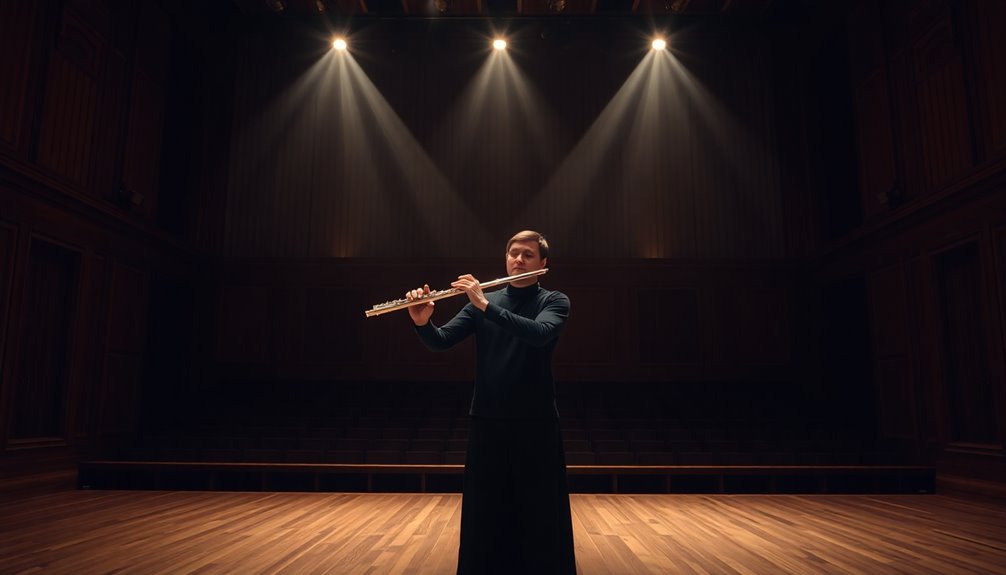
Building on the ethereal qualities found in Jolivet's "Cinq Incantations," Gabriel Fauré's "Fantasie" presents a different yet equally enchanting approach to flute performance. Here, Fauré's influences from French Romanticism shine through, wrapping the listener in a rich tapestry of sound that resonates with emotional depth. As you immerse yourself in this piece, you'll notice how the flute dances through intricate melodic lines, showcasing the technical mastery that both performers and listeners cherish.
Fauré's harmonic innovation is particularly striking, as he deftly blends traditional structures with fresh, unexpected progressions. The opening section captivates your attention, inviting you into a world where every note seems to breathe life. You can almost feel the dialogue between the flute and the piano, each instrument complementing the other while exploring themes of longing and joy.
In the middle section, the tempo shifts, creating an exhilarating contrast that demands precision from the flutist. This challenge not only highlights the technical prowess required but also deepens the emotional experience, allowing you to connect with the music on a personal level.
As you listen, you might find yourself swept away by the evocative phrasing and lyrical beauty, feeling a sense of belonging to something timeless. The emotional depth of flute music often enhances storytelling, inviting listeners to engage with the piece in a profoundly personal way.
Fauré's "Fantasie" stands as a demonstration to the power of the flute, inviting you to appreciate its nuanced expressions and the sheer artistry involved in bringing this masterpiece to life.
"The Magic Flute" by W.A. Mozart
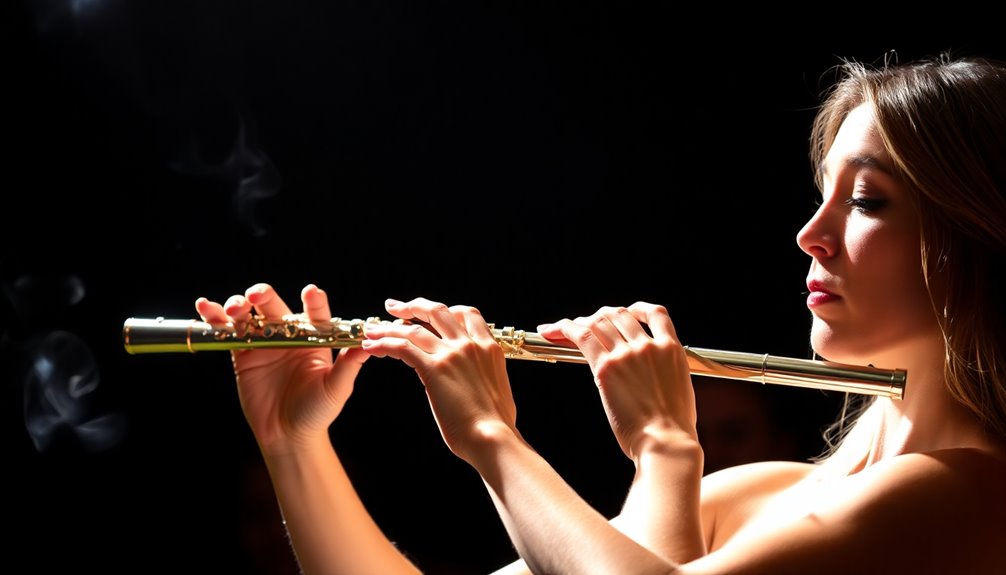
At the heart of W.A. Mozart's "The Magic Flute" lies a fascinating blend of enchanting melodies and profound thematic development. This opera is a true showcase of the flute's expressive capabilities, allowing you to experience the instrument's versatility and emotive power.
As you engage with the score, you'll discover how Mozart's inspiration from folklore and enlightenment ideals shapes the music.
Here's what makes "The Magic Flute" a standout piece for flute solos:
- Memorable Melodies: The arias and duets resonate with audiences, creating an emotional connection.
- Rich Textures: The interactions between the flute and other instruments highlight its unique timbre.
- Dramatic Contrast: Moments of tension and release keep you engaged, reflecting the opera's narrative.
- Symbolic Themes: The exploration of wisdom, love, and the triumph of light over darkness resonates deeply.
- Technical Challenges: The intricate passages demand skill, pushing you to grow as a flutist.
Each note you play in "The Magic Flute" carries a weight of significance, inviting you to explore your own emotional landscape. Additionally, understanding the historical context of the piece enhances your interpretation and performance.
The thematic development weaves throughout the opera, creating a compelling journey that feels both personal and universal. As you master this piece, you'll not only showcase your talent but also connect with the timeless legacy of Mozart's genius.
Embrace this masterpiece, and let the magic of the flute transport you and your audience to a dimension of beauty and inspiration.
Frequently Asked Questions
What Are the Best Techniques for Playing Flute Solos Effectively?
To play flute solos effectively, focus on mastering breath control and dynamic expression.
You'll want to practice breath support, ensuring your notes resonate with clarity and fullness.
Experiment with varying your volume and intensity; it adds depth to your performance.
Don't forget to connect emotionally with the piece—your audience will feel it.
As you refine these techniques, you'll find your solos become not just notes, but compelling stories that resonate with everyone listening.
How Do I Choose the Right Flute for Solo Performances?
Choosing the perfect flute for your solo performances is like finding a partner who understands your every note.
Explore various flute brands, each with their unique voice, and consider how they resonate with your style.
Don't forget about instrument maintenance; a well-cared-for flute sings more sweetly.
Test different models, listen to how they respond, and trust your instincts to find one that feels like an extension of yourself.
You're destined to shine!
What Are Common Mistakes to Avoid in Flute Solos?
When performing flute solos, it's essential to avoid common mistakes that can hinder your expression. Neglecting breath control can lead to shaky notes and uneven phrasing.
Additionally, failing to explore your dynamic range limits your emotional impact. Make certain you practice scales and dynamics consistently to build your skills.
How Can I Improve My Stage Presence During Solo Performances?
To improve your stage presence during solo performances, focus on fostering fantastic body language and vibrant audience engagement.
Stand tall, project confidence, and use expressive movements to connect with your listeners. Practice making eye contact and smiling; these simple gestures can create a warm atmosphere.
What Types of Flute Music Are Best for Competitions?
When choosing competition repertoire, consider pieces that highlight your strengths and showcase your performance dynamics.
Look for compositions that challenge you technically while allowing emotional expression. Baroque or contemporary works often captivate judges and demonstrate versatility.
Engaging pieces, like a spirited sonata or a lyrical concerto, can create a strong connection with the audience.
Ultimately, select music that resonates with you, as your passion will shine through and elevate your performance.
Conclusion
In exploring these ten flute solos, you've journeyed through a vibrant tapestry of sound, each piece a unique brushstroke on the canvas of classical music. Imagine the ethereal notes soaring like a bird in flight, each melody inviting you to lose yourself in its beauty. These compositions don't just showcase talent; they encapsulate emotion, storytelling, and history. So, grab your flute, and let these masterpieces inspire your own musical adventures, inviting the world to hear your voice.

